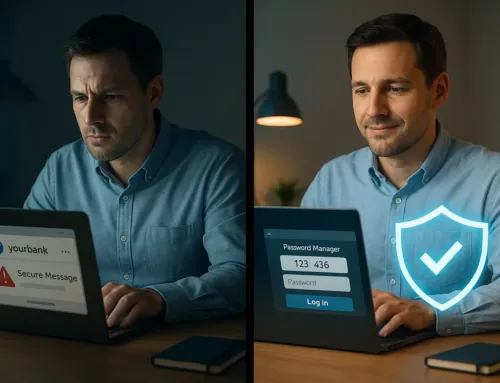How to Build a Cybersecurity Response Plan (Before You Actually Need One)
The worst time to plan for a cyberattack is during one.
Unfortunately, that’s when most small businesses realize just how unprepared they are. One wrong click, one exposed vulnerability, or one stolen password, and suddenly you’re locked out of your systems, your customer data is at risk, and panic sets in.
The truth is: cyberattacks aren’t just a problem for big corporations anymore. Small and mid-sized businesses are increasingly becoming prime targets, precisely because they often lack a formal response plan.
In this post, we’ll walk you through exactly how to build a cybersecurity response plan tailored to the needs (and realities) of SMBs. You’ll learn what to include, who should be involved, and how to put the right tools and processes in place, so if an attack happens, you’re not scrambling…you’re ready.
Why SMBs Need a Cybersecurity Response Plan
Many small business owners assume they’re too small to be a target. Unfortunately, that’s exactly what makes them appealing to cybercriminals.
The Data Tells a Different Story:
These aren’t just numbers—they’re cautionary tales.
Why SMBs Are Vulnerable
Limited Resources:
Smaller budgets mean fewer cybersecurity tools and protections
No In-House IT:
Many SMBs lack dedicated security staff or expertise
Outdated Systems:
Legacy software and lax password practices are common
Reactive Posture:
Without a formal plan, responses are often delayed, chaotic, and costly
And it’s not just about money. A breach can erode customer trust, damage your reputation, and lead to compliance violations—especially if you handle sensitive customer data like credit cards, personal information, or health records.
A Response Plan = Risk Control
A cybersecurity response plan helps you act quickly and decisively when something goes wrong. It defines roles, outlines procedures, and ensures that everyone, from leadership to frontline staff, knows exactly what to do when seconds count.
Core Components of a Cybersecurity Response Plan
A well-crafted cybersecurity response plan doesn’t need to be hundreds of pages long, but it does need to be clear, actionable, and tailored to your business. Think of it as your playbook for navigating a worst-case scenario with clarity instead of chaos.
The Essential Building Blocks
1. Roles & Responsibilities
Clearly define who’s doing what in the event of an incident.
- Who leads the response?
- Who contacts stakeholders?
- Who works with vendors or IT support?
This avoids confusion, delays, and duplicated effort.
2. Detection & Escalation Procedures
Outline how incidents are identified and reported internally.
- What tools or alerts signal a problem?
- How should employees report suspicious activity?
- What’s the chain of escalation?
Early detection is everything—this part gets everyone aligned on what’s worth reporting and how fast to act.
3. Containment, Eradication & Recovery
Describe how you’ll isolate the threat, eliminate it, and restore systems.
- Can infected devices be quarantined?
- How do you safely bring operations back online?
- Are there verified backups available?
This section should be practical, not theoretical. The goal: minimize damage and recover swiftly.
4. Internal & External Communication Plan
Who gets notified, and how?
- Internal: staff, leadership, and IT teams
- External: customers, legal counsel, media, or authorities if necessary
Miscommunication (or silence) during a crisis can lead to lost trust and even legal trouble. Prepare templates in advance.
5. Post-Incident Review
After the dust settles, evaluate what happened.
- What worked well?
- Where did gaps appear?
- How can the plan improve?
This step ensures your plan evolves with each test or real-world event.
How to Build Your Cybersecurity Plan: Step-by-Step
Building a cybersecurity response plan might sound overwhelming—but it’s far more manageable (and less costly) than dealing with an attack unprepared. Here’s how to approach it one clear step at a time.
Step 1: Assess Your Current Environment
Start by understanding what you’re working with.
- What systems store sensitive data?
- Where are your vulnerabilities (e.g., outdated software, weak passwords)?
- Are you already using any monitoring or security tools?
A risk assessment—either self-conducted or with a provider like SERVD I.T.—is the foundation for everything that follows.
Step 2: Identify Critical Assets and Threats
Not everything in your business is equally valuable or vulnerable.
- Highlight mission-critical systems (POS, cloud apps, customer databases)
- Consider your most likely threats: phishing, ransomware, internal errors, etc.
This helps prioritize response actions and allocate resources effectively.
Step 3: Define Roles and Escalation Paths
Create a clear structure for how incidents will be reported and handled.
- Assign roles like Incident Lead, Comms Contact, and IT Response Lead
- Define who needs to be informed at each escalation level
- Document response timelines (e.g., respond within 15 minutes of detection)
Don’t assume your team will “figure it out”—spell it out.
Step 4: Draft Response Playbooks
For common incidents (like phishing or a lost laptop), write out step-by-step procedures.
- What are the first 3 actions taken?
- Who’s responsible?
- What tools or resources are needed?
Think of these as checklists your team can follow under pressure.
Step 5: Test and Refine Regularly
A plan that’s never tested is a plan that won’t work.
- Run tabletop exercises: walk through a simulated breach scenario
- Debrief afterward: what worked, what didn’t
- Update your documentation accordingly
Quarterly testing is ideal—even a short 30-minute review can make a big difference.
With these five steps, your business moves from being vulnerable to being prepared, turning chaos into a coordinated response.
Tools and Support: What You’ll Need in Place
A solid plan is critical, but without the right tools and support, even the best plan can fall flat.
Think of this section as your cybersecurity toolkit: the essential technologies and partners that make your response plan executable in the real world.
Endpoint Detection & Monitoring
You can’t respond to what you don’t see.
- Use antivirus and endpoint detection tools to monitor devices for unusual behavior
- Enable real-time alerts for suspicious activity, like unauthorized access or file changes
- Consider an MDR (Managed Detection and Response) service for around-the-clock protection
This is your digital early warning system.
Data Backup & Recovery Systems
If your systems go down, how fast can you bounce back?
- Regular, automated backups (ideally stored offsite or in the cloud)
- Fast recovery capabilities for critical systems and files
- Encryption to ensure data integrity and security
Without verified backups, ransomware recovery becomes a painful guessing game.
Work With a Managed Cybersecurity Partner
Many SMBs don’t have the time or expertise to manage cybersecurity in-house—and that’s okay.
- Managed service providers (like SERVD I.T.) offer scalable support, proactive monitoring, and response-ready teams
- They can help build your plan, test it, and step in during an actual breach
- You gain peace of mind without hiring a full-time security team
Think of it as adding a cybersecurity department—without the overhead.
Train Your Team
Technology alone isn’t enough—people are often the weakest link.
- Conduct regular training on phishing, password hygiene, and safe data handling
- Run simulated phishing tests to reinforce awareness
- Include staff roles in your incident response drills
A well-trained employee can stop an attack before it starts—or report it before it spreads.
When these tools and partnerships are in place, your response plan becomes a powerful safety net—not just a document.
Case Study Snapshot: The Cost of Not Being Ready
To understand just how damaging the lack of a response plan can be, consider this real-world example from a local retail client who reached out to SERVD I.T.—after the damage was already done.
The Situation
A small regional retailer with three locations was hit with a ransomware attack that encrypted their point-of-sale systems and customer data.
They had no formal response plan, no working backups, and no clarity on who to call—or what to do.
What Went Wrong
Delayed Detection:
The attack began overnight and wasn’t discovered until employees arrived the next morning.
No Clear Roles:
Management didn’t know who was responsible for leading the response or contacting law enforcement.
Lack of Backup:
Daily sales and inventory data were unrecoverable.
Missed Communication:
Customers found out through social media rumors rather than the company directly.
The Fallout
What Could Have Been Different
If the company had a basic response plan prepared, they could have:
- Detected the breach faster
- Contained the damage early
- Restored systems within hours using clean backups
- Reassured customers with clear, professional communication
You don’t need to be perfect — you just need to be prepared.
When It Comes to Cybersecurity, Prepared Beats Perfect
Cyber threats are no longer a matter of if, they’re a matter of when.
And when that time comes, having a clear, tested cybersecurity response plan can mean the difference between a minor disruption and a full-scale business crisis.
Whether you’re protecting sensitive customer data, your reputation, or your ability to operate, the time to prepare is before the incident – not during it.
Let’s Make Sure You’re Ready
Need help getting started?
Schedule a free Cybersecurity Health Check with SERVD I.T. today and get expert guidance tailored to your business.




